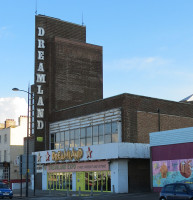
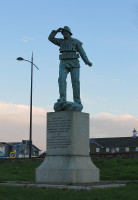
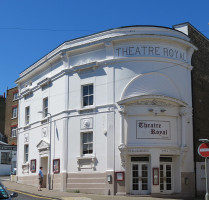
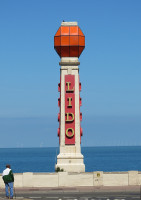
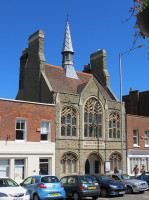

Margate, which with its twin, Ramsgate, shares duty as chief town in the Isle of Thanet on the north east bit of Kent, is a seaside resort with some small interest to these pages. The town contains three statues and a Victorian clock tower, and the parish church has an interesting collection of mostly minor wall monuments.
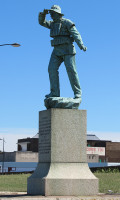
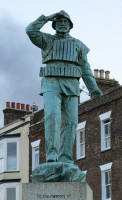
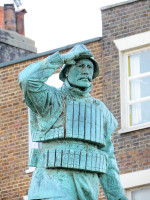 Views of the Margate Surfboat Memorial, by Frederick Callcutt.
Views of the Margate Surfboat Memorial, by Frederick Callcutt.
Immediately exiting the station and going to the shore, to the left is a statue of a sailor looking out to sea. Variously known as the Margate Memorial, the Lifeboat Memorial and the Surfboat Friend to All Nations memorial, it commemorates the sinking of the surfboat – sort of an alternative lifeboat – of that name at Margate in 1897 after it was launched to aid a sinking ship. The pose is arresting: the standing figure, in his thick oilskin dress and wearing a primitive life jacket (unlike, said the inquest, the actual sailors who died), peers out to sea, one hand shading his eyes, other hand clenched in a determined fist. He has moved one leg forward, as he unconsciously tries to get closer to what he is looking at. It is a well-caught attitude. The detail of the statue is less good: the face is bland, the folds and wrinkles of his clothing sketchy and not particularly convincing, the legs trunk-like, which is due to the heavy trousers but could have been easily avoided with a suitable fold. The piece is signed by the sculptor, Frederick Callcott (1853-1923) and dated 1899, and stamped by Elkingtons, the founders. This seems to have been the main work by this rather obscure sculptor: Callcutt was also responsible in part for bronze panels inside the Black Friar Pub, on the corner of Queen Victoria Street in the City of London, and exterior figurework on a pub in Black Prince Road, Lambeth, has also been ascribed to him.
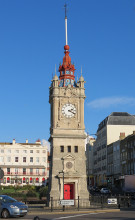 Margate's Jubilee Clock Tower, 1887-89.
Margate's Jubilee Clock Tower, 1887-89.
The road and beachfront leads naturally to the right, and town. Note on the land side of the road, the entrance block to the Dreamland amusement park, derelict and strangely iconic beach architecture (see top of page, left). There is some slighter beach architecture too, including fishy lamps (also see top of page).
Down by the beach, the principal monument is Margate's Jubilee Clock Tower, a mid-Victorian edifice of a type characteristic of its times, but particularly impressive in its bulk. It is, like others of its breed, somewhat inspired by Big Ben, being a square tower with a clock face on each side, and pinnacles above with a central spire, though not Gothic but somewhat Renaissance in style. It is formed of three stages. The lowest stage has a portico facing towards the station, above which, at first floor height, is a blind window with triangular pediment, with the centre filled by a bronze roundel containing a relief portrait of Queen Victoria. There is a similar device on each side: one roundel has simply a crown, the word Jubilee, and the date 1887; the other two contain portrait medallions of Prince Albert and, I think, Queen Mary. These portraits are seaside quality, being cheerful rather than pretending to any artistic merit, the Prince Albert with his Daliesque moustache and crinkly ear being the jolliest (see picture below, you will need to click to enlarge), but the stone carving around, including grotesque lion-heads below two of the roundels and various flowers, is of high quality, alas, somewhat beaten up by time and weather.
Above, little rectangular windows, and then a string course (shelf) and the second stage.
This includes the clock faces on each side, set in a square within a larger space,
with the corners of the building at this stage marked by Octagonal attached pilasters,
rather Tudorish, and low relief carving above and below each clock, and the words ‘Victoria Jubilate’.
On the lower shelf sit heraldic dragonlike beasts holding shields –
again they are of superior workmanship, and above, there are swan-necked pediments, rather Baroque,
and corner pinnacles, again baroque and with nice sharp spears on top.
Within this structure is the third stage, a cast iron steeple of three short stages,
with open ironwork so the sound of the bells within can be heard, little lion heads, mini-pinnacles,
and at the top, a ball and tall staff rising to a weathervane. Altogether, a totally good thing.
The 1887 date was of course the 50th anniversary of Victoria’s reign,
but the tower was only completed in 1889, being built to the design of the not so well known architect
Henry Cheers.
The view towards the East sweeps satisfyingly round the harbour to the end of the promenade,
just before which is a curious little building which is now the Tourist Information Centre,
but was built in 1812 as Droit House, ‘erected for the accommodation of the directors [of the harbour]
and their officers... a small, but very handsome stone building, from the centre of which rises a bell
and clock turret, having four illuminated faces’.
Going past the Jubilee Tower and climbing the hill takes the visitor to the natural centre
of the town, which is Cecil Square, from which pleasant perambulations in all directions can be made.
The most interesting of these is along the High Street to the principal church of Margate,
St John the Baptist.
The High Street starts grimly, in the spirit of 1960s rebuilds, but within the tiny shopping mall
off to one side is Margate’s second statue, a modern nude poised above a tall base of wood and stones,
entitled Tethys, Goddess of the Sea, by the sculptor Fleur Gray.
It is lacking in detail, making the projecting hand and foot, and particularly the hair,
look weak, but the contours of the body and legs are nicely feminine when seen in profile.
Further on up the High Street, the 60s or 70s buildings give way to earlier ones,
including the Masonic Hall, ruined at street level but preserving tall windows and pilasters above
and a balustrade. Continuing, a feature near the end is a tall Victorian building,
appearing rather grand with six stories and tall slate roof towering above its three-storey neighbours.
At the base of this is a tavern called The Man of Kent with twin porticos,
with identical but reversed painted tile figures on the spandrels above the arched doorways.
Each shows a Chinese couple in traditional dress, the man with an umbrella hat,
long whiskers and pigtail, and wide sleeved smock above baggy trousers,
and carrying boxes from a stick across his shoulder. The woman, who has long pins in her hair,
and even wider sleeves than the man, is drinking tea.
The background shows a half-seen pagoda like building on one side, and a sideboard with a peony
or similar flower in a porcelain bowl and some bronze bowl for delicacies on the other.
Excellent design, and the building contains nice though simple detail of stonework and ironwork above.
Carrying on further reaches the Church, St John the Baptist.
It is of a broad building of nave with two equally high aisles with separate roofs,
and a prominent tower with tall, heavy spire. This tower is in the main 14th Century,
through the whole Church had a Victorian makeover which saw the tower being heightened.
It contains a collection of mostly rather simple wall panel monuments, but with some sculptural interest - see this page.
Behind the Church, viewable from the Churchyard, is the modest spire of the Roman Catholic church
of St Austin and St Gregory. There are various other churches dotted around the town, including a Gothic
Baptist church in Cecil Square (see top of page), and
most particularly in Cliftonville, east of the centre, where there is the large St Paul,
and the rather grand, and excellently sited, St Michael and St Bishoy, belonging to the Coptic church.
In Dane Park, the most central of Margate’s parks, is a grand fountain,
typical seaside town architecture, a cast iron structure from the 1890s. It was put up,
says the little sign next to it, in memory of John Woodward, who gave the land for the park to Margate
and further land to pay for its upkeep. The fountain has at the top our third Margate statue,
a standing girl in long Classical robes, holding up a lilly in one hand, from which water presumably
once gushed. Her other arm, modestly across her upper body, appears to be holding up one edge of
her gown which has slipped off the raised shoulder. She wears upon her head a wreath of olives.
Below, a small shelly bowl, then a column to the larger bowl beneath, with around the central shaft
four herons, little wings raised, beaks against their breasts, standing among low reeds and waterlilies.
The lower bowl, which has a a decorated edge of leaves, perhaps oak, and corrugated,
is on a broader shaft which widens to a drum around which are great fish of classical design,
with big eyes, dolphin-like faces, spiky fins and upward coiled tails ending in trefoil tailfins (if you like fish sculpture, see this page);
between these on the central shaft are low relief scenes of fishing cherubs, and beneath, small
protruding lion heads. At one time, the water would have splashed down from upper figure via the
two bowls to a wide stone basin, but this was filled in during the 1980s to form a flowerbed.
A fine piece of late Victorian ironwork.
There is various other nice architecture in the Old Town, and scattered around, including things like the Theatre Royal (see top of page), but nothing particularly sculptural
though pretty enough. On the shore towards Cliftonville is the Lido, with a really iconic sign,
shown below, dating I would think from the 1920s or 1930s.
Dimly seen in the distance out to sea are the vast flock of windmills which form the London Array.
But we are drifting far from the interests of this website. We end by noting that there is in fact
one last figural sculptural piece in Margate, back at the station, where inside the station hall
is a clock with two cherub supporters, of Derby manufacture. In painted ceramic, with two trumpets of fruit and flowers,
sort of cornucopias but not quite, at the base.
Also in Margate - St John the Baptist Church // Sculpture in some English towns // Sculpture pages
Visits to this page from 17 Nov 2014: 12,750
Tourist Information Building (Droit House)
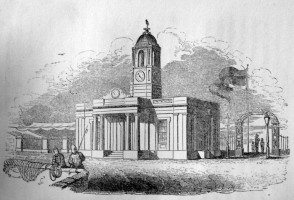
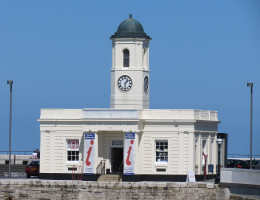 Droit House, now Margate's Tourist Centre.
Droit House, now Margate's Tourist Centre.
Margate High Street
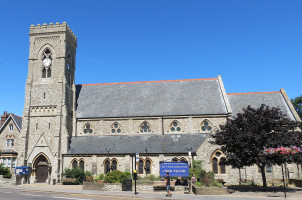
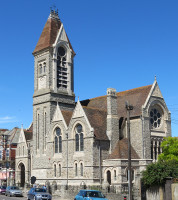 Cliftonville Churches: St Paul, and Coptic St Michael & St Bishoy.
Cliftonville Churches: St Paul, and Coptic St Michael & St Bishoy.
Dane Park fountain
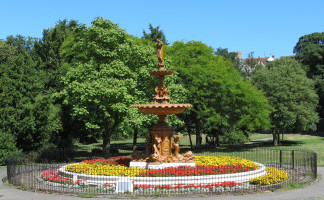 John Woodward Memorial Fountain, Dane Park
John Woodward Memorial Fountain, Dane Park